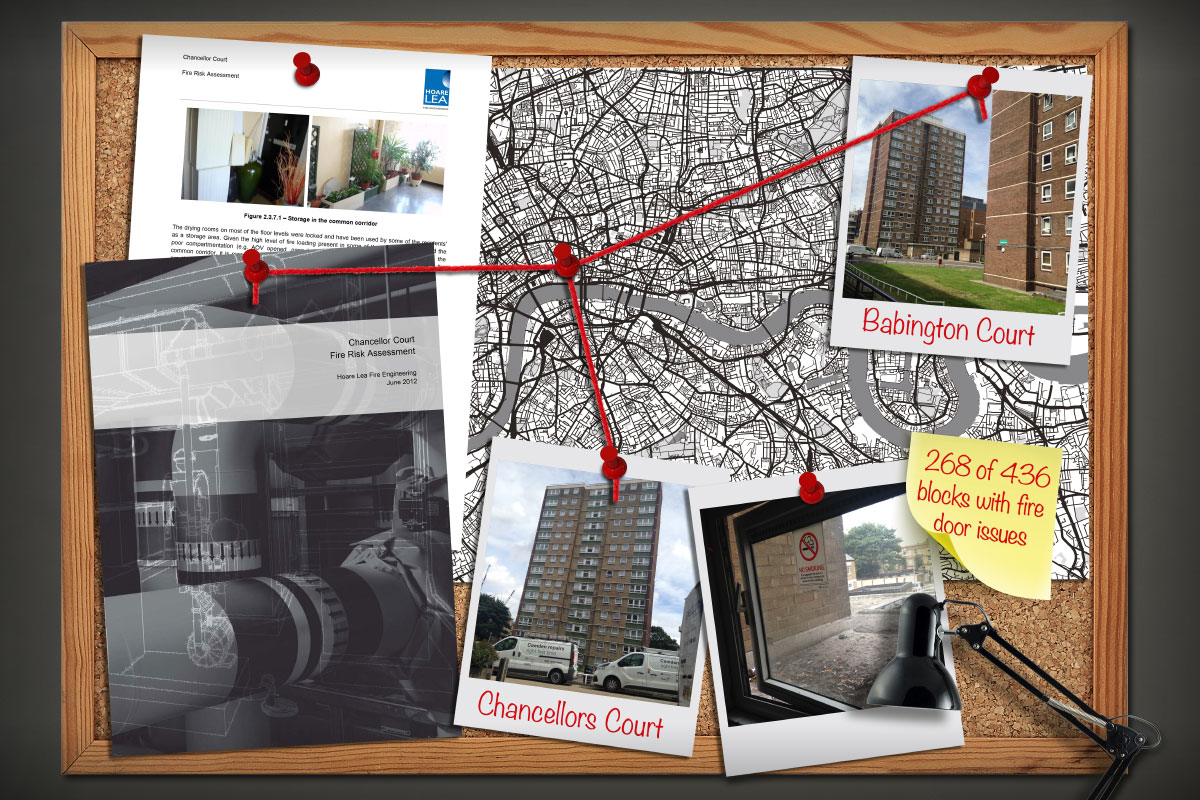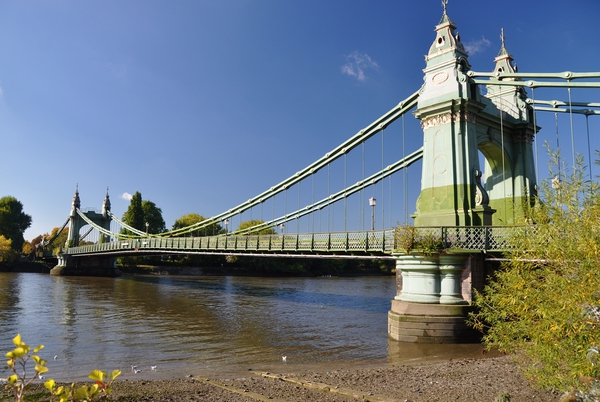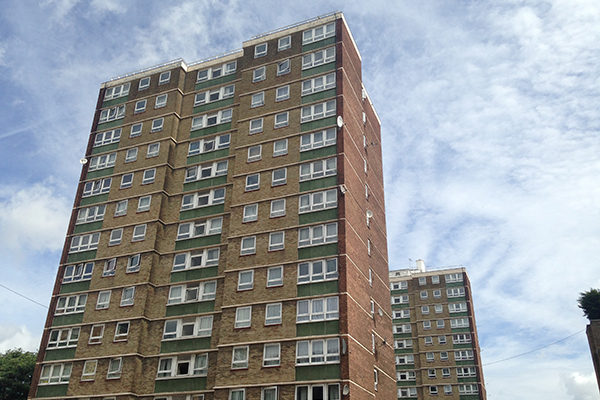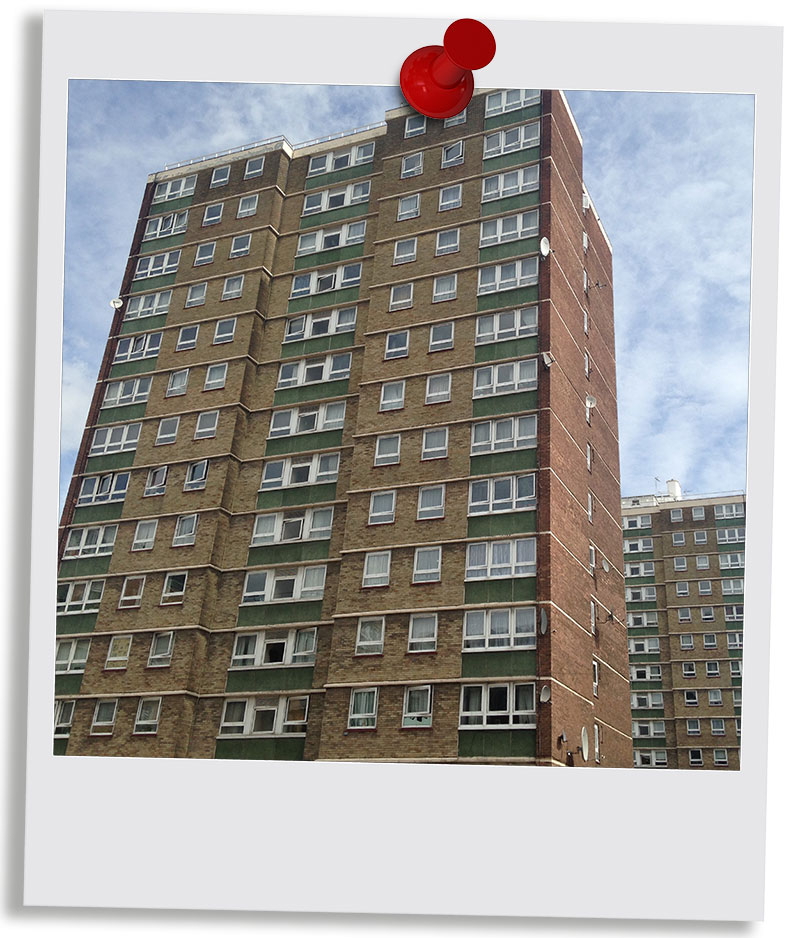You are viewing 1 of your 1 free articles
Revealed: the most common fire safety problems in tower blocks
Inside Housing’s investigation of high-rise fire risk assessments revealed frequent issues in tower blocks. Sophie Barnes takes a look at the most common problems. Photography by Nathaniel Barker
Bloomsbury, London. Babington Court and Chancellors Court are two ordinary post-War council housing blocks. In the courtyard outside the two identical 14-storey buildings, families drift past and older women carry bags of groceries to their homes. You could be on any council estate in the country. You certainly wouldn’t think you were in the heart of central London, just a few minutes’ walk from Holborn station and the bright lights of the West End.
Inside the block, long-standing council tenants rub shoulders with private tenants paying £3,000 a month to live in one of the most illustrious postcodes on the planet. Their lives and lifestyles vary greatly. But there is a significant leveller. At some point over the past five years, they have all been living in a building which fire risk assessors say poses a “substantial” risk to life.
In the weeks following the Grenfell Tower disaster, attention rightly turned to the cladding system on the outside of the building that appears to have allowed the blaze to spread. But fire safety is about much more than what is on the outside of a building. Internal features such as fire doors, vents and escape routes can be the difference between life and death in a high-rise fire.
The public inquiry will, it is hoped, establish whether or not these features performed properly in the Grenfell blaze, but to understand where the common problems are, Inside Housing decided to look at other properties.
We asked 153 social landlords to provide their most recent fire risk assessments (FRAs), and have so far received them from 36 councils. Housing associations, not subject to Freedom of Information Act (FOIA) laws, were less transparent, with only seven providing the documents.
The research is intended to create a resource for social landlords and other stakeholders, including tenants, to better understand the potential risks to their properties.
Indeed, the 436 FRAs provided paint a worrying picture: there were fire safety problems in the majority of blocks, with 61% experiencing some issue with fire doors, a further 71 blocks with problems with emergency lighting and 109 with holes or gaps in service rooms such as electrical cupboards and drying rooms. There were also exposed pipes or cables hanging down from ceilings in 44 blocks, and 54 had no ventilation or faulty ventilation in staircases to clear smoke from a fire.
To see details of the main issues uncovered click here
To see the full list of FRAs click here
In eight of the 436, the problems were so severe that the risk assessor ranked the property as posing a “substantial” risk to life. Two of these were Babington Court and Chancellors Court, which – like Grenfell – sit awkwardly in the heart of one of London’s wealthiest areas.
The issues identified in these two buildings were manifold. Corridors and airing cupboards were used as storage rooms. Tenants smoked in the corridors and stubbed out their cigarettes on windows, melting the uPVC frames. Many fire doors were non-compliant. Smoke alarms were damaged. Smoke vents were not fire-stopped. The list went on.
Recurring problems
This assessment was made in 2012. Camden carried out more recent assessments in June this year, which downgraded the risk to normal, after Inside Housing’s FOIA request. A spokesperson said the council carried out works to address highlighted issues, including to tenants’ front entrance doors, and is carrying out works to address other issues as highlighted by the recent FRA reports.
When Inside Housing visited the buildings, there were signs of improvement. But significant issues remain. Cigarette butts litter the windows and there is a smell of tobacco smoke in the air. At least one of the doors from the drying room to the main corridor does not close by itself. And the panel doors on electricity boxes are made of tatty plywood, leaving significant gaps from the wall.
“You need a massive wealth of knowledge to properly fire risk assess a tower block.”
The FRA said doors should be replaced by September 2012, and many look new. But residents say they were only installed last year. And there appear to be several old front doors scattered through the building.
These kinds of problems with fire doors were the most frequent issues in the FRAs we saw. As Hannah Mansell, technical manager at the British Woodworking Federation, says, they “come up over and over again as one of the big things” in risk assessments. A particular problem in relation to this is rooted in the Right to Buy, which has pepper-potted tower blocks with leaseholders and private landlords.
These private owners may replace doors with more attractive or security-conscious alternatives that have a lower fire rating. “The problem is the council thinks they don’t have the power to change the front door [of a leaseholder’s flat],” says Ms Mansell.
However, she says a 2015 court case brought by Croydon Council has made it much easier. In what was deemed a ‘test case’ at Croydon County Court, the council sued a leaseholder who was denying access for her uPVC door to be changed. The council won the case, setting a precedent for other social landlords. Many landlords, however, are not aware of this change, Ms Mansell says.
The presence of holes in walls and ceilings was another major, and frequent, issue flagged by the risk assessments. Improper fire doors, holes and gaps, and poorly boxed-in pipes all represent breaches in a building’s compartmentation – the technical name for its ability to contain a blaze in a single flat.
As is now notorious in the aftermath of Grenfell, tenants are usually advised to ‘stay put’ in their flats when a fire breaks out. This relies on the compartmentation functioning properly, which means finding and fixing potential breaches could not be more important.
Other frequent issues included were flammable items, such as mobility scooters, blocking escape routes and an absence of emergency lighting in stairways and other communal areas – an issue which appears to have been the case at Grenfell. Survivors have recalled the terror of being forced to feel their way in the dark down the staircase to escape with no emergency lighting to guide them.
Too basic?
While it is positive that these issues have been identified by the FRAs, there is scepticism among experts about how useful the assessment process is. Of the 436 risk assessments seen by Inside Housing, 305 were identified as Type 1 – the most basic form of assessment which only looks at the communal areas of a block and a sample of front doors. The rest did not specify. While the Local Government Association’s guidance states this will “normally be sufficient for most blocks of purpose-built flats”, experts disagree.
Ronnie King, honorary secretary of the All-Party Parliamentary Fire Safety and Rescue Group, says: “Unless assessors go into flats and the cavities and ducting then there’s no point. Fire resistance can get punctured by people breaking into cavities to do other work,” he says.
Our analysis found that the level of detail provided could vary quite substantially. Some had questions relating to issues such as the presence of combustible items in corridors and then a simple ‘yes’ or ‘no’ tick box. Others had detailed comments and a risk scale. While eight graded the risk to life as substantial, 77 had no grading.
Part of the problem, experts say, is that the regulations are too vague. There is no requirement on who should carry out FRAs and no specific requirement on how frequently. In Babington Court and Chancellors Court, Camden waited five years before assessing the buildings again.
“Some of the risk assessments I’ve seen were just so basic that they simply wouldn’t do for a high-rise building and are not worth the paper they are written on,” says Ms Mansell. “The qualifications presented by fire risk assessors can be so varied. You need a massive wealth of knowledge to be able to properly fire risk assess a tower block and you can tell from some of the assessments that some of them don’t really have a clue.”
Since the Grenfell Tower fire a number of social landlords have switched to Type 3 and Type 4 fire risk assessments – the most rigorous types – as a matter of course. These assessments look inside flats, at the compartmentation between flats, and at the means of escape.
This, perhaps, points the way forward. Inside Housing’s Never Again campaign also calls for risk assessments to be carried out annually. Social landlords, and housing associations in particular, could also do with becoming more transparent about what their assessments have found.
As the horrible reality of the past month has proved, when it comes to fire safety, the stakes are just too high not to know the risks.
Additional reporting by Pete Apps and Nathaniel Barker
Never Again campaign
In the days following the Grenfell Tower fire on 14 June 2017, Inside Housing launched the Never Again campaign to call for immediate action to implement the learning from the Lakanal House fire, and a commitment to act – without delay – on learning from the Grenfell Tower tragedy as it becomes available.
One year on, we have extended the campaign asks in the light of information that has emerged since.
Here are our updated asks:
GOVERNMENT
- Act on the recommendations from Dame Judith Hackitt’s review of building regulations to tower blocks of 18m and higher. Commit to producing a timetable for implementation by autumn 2018, setting out how recommendations that don’t require legislative change can be taken forward without delay
- Follow through on commitments to fully ban combustible materials on high-rise buildings
- Unequivocally ban desktop studies
- Review recommendations and advice given to ministers after the Lakanal House fire and implement necessary changes
- Publish details of all tower blocks with dangerous cladding, insulation and/or external panels and commit to a timeline for remedial works. Provide necessary guidance to landlords to ensure that removal work can begin on all affected private and social residential blocks by the end of 2018. Complete quarterly follow-up checks to ensure that remedial work is completed to the required standard. Checks should not cease until all work is completed.
- Stand by the prime minister’s commitment to fully fund the removal of dangerous cladding
- Fund the retrofitting of sprinkler systems in all tower blocks across the UK (except where there are specific structural reasons not to do so)
- Explore options for requiring remedial works on affected private sector residential tower blocks
LOCAL GOVERNMENT
- Take immediate action to identify privately owned residential tower blocks so that cladding and external panels can be checked
LANDLORDS
- Publish details of the combinations of insulations and cladding materials for all high rise blocks
- Commit to ensuring that removal work begins on all blocks with dangerous materials by the end of 2018 upon receipt of guidance from government
- Publish current fire risk assessments for all high rise blocks (the Information Commissioner has required councils to publish and recommended that housing associations should do the same). Work with peers to share learning from assessments and improve and clarify the risk assessment model.
- Commit to renewing assessments annually and after major repair or cladding work is carried out. Ensure assessments consider the external features of blocks. Always use an appropriate, qualified expert to conduct assessments.
- Review and update evacuation policies and ‘stay put’ advice in the light of risk assessments, and communicate clearly to residents
- Adopt Dame Judith Hackitt’s recommended approach for listening to and addressing tenants’ concerns, with immediate effect
CURRENT SIGNATORIES:
- Chartered Institute of Housing
- G15
- National Federation of ALMOs
- National Housing Federation
- Placeshapers
The Grenfell Tower Inquiry
Closing statements
Day 85: victims' lawyers attack the fire brigade
Further expert evidence
Including some additional evidence from emergency call handlers, bereaved and relatives
Day 84: further evidence from survivors and relatives
Day 83: swift evacuation of tower possible if residents alerted
Day 82: initial fire was extinguished but then returned to the flat
Day 81: overheating fridge-freezer most likely cause of fire
Day 80: fire doors installed did not match product tested
Day 79: resident advised to stay put despite fire in flat
Day 78: insulation and cladding material below required standard
Day 77: molten plastic spread blaze down tower
Day 76: 'stay put' should be dropped when fire spreads across floors
Other witness evidence
Police, ambulance, gas suppliers, council, TMO and call room operators give evidence
Day 75: call room operators give evidence
Day 74: further evidence from TMO officers
Day 73: TMO boss failed to pass information to firefighters
Day 72: fire finally extinguished when gas switched off
Day 71: further questions over stay put advice
Day 70: the police evidence
The bereaved, survivors and relatives’ evidence
Day 69: video shows smoke billowing through fire door
Day 68: KCTMO removed self closing mechanism and never replaced it
Day 67: gaps in cladding fixed with duct tape
Day 66: 'don't fix broken system with a sticking plaster'
Day 65: survivor dragged disabled man down nine floors to safety
Day 64: KCTMO 'did not replace broken fire door'
Day 63: foam insulation inside cladding 'exposed' says survivor
Day 62: father gives harrowing account of son's death
Day 61: council’s management organisation slammed for faulty electrics
Day 60: stay put advice ‘led to deaths’, residents say
Day 59: residents describe problems with new windows
Day 58: survivor describes how daughter saved his life
Day 57: firefighter evidence ‘a slap in the face’, says survivor
Day 56: relations with contractor were ‘toxic’
Day 55: resident 'never happy' with stay-put advice
Day 54: tenant gives evidence about housing association
Day 53: stay put advice 'felt like trap'
Day 52: resident saved by son's phone call
The firefighters’ evidence
Day 51: firefighter feared encouraging residents to jump
Day 50: the LFB commissioner
Day 49: fire chief reveals frustration over lack of building plans
Day 48: internal fire spread 'bigger story' than cladding
Day 47: fire officer considered evacuating crews over building collapse fears
Day 46: 'we were improvising' senior firefighter admits
Day 45: firefighter urged for abandonment of 'stay put' policy
Day 44: firefighter recalls radio signal difficulties
Day 43: call hander 'uncomfortable' with insisting residents stay put
Day 42: residents only told to leave if they called fire brigade back
Day 41: breathing equipment delay 'hampered rescues on upper floors'
Day 40: chiefs told firefighters to abandon policy
Day 39: firefighters reveal dramatic rescue of children
Day 38: firefighters issue aplogies to families
Day 37: council 'unable to provide tower plans'
Day 36: QC defends inquiry process
Day 35: Javid would welcome interim recommendations
Day 34: water from hose 'too weak' to reach the flames
Day 33: 'oh my god, we've been telling people to stay put'
Day 32: further fire fighter describes lack of equipment and low water pressure
Day 31: 'incredibly difficult' task of recording information outlined
Day 30: struggle to maintain control over rescue operation described
Day 29: fire service 'overwhelmed' by survival guidance calls
Day 28: 'the building beat us'
Day 27: firefighters 'forced to abandon plans to reach roof'
Day 26: poor signage hindered rescue efforts
Day 25: water pressure left firefighting equipment 'like garden hose'
Day 24: decision to abandon 'stay put' explored
Day 23: TV images 'could have assissted' rescue effort
Day 22: description of hectic scenes in the control centre
Day 21: account from the fire service 'nerve centre'
Day 20: firefighter describes 'huge volume' of calls from trapped residents
Day 19: firefighter 'given no training on cladding fires'
Day 18: evacuation would have been 'huge catastrophe'
Day 17: firefighters describe access and lift issues
Day 16: scenes of carnage likened to 9/11
Day 15: firefighters recount trauma of survival guidance calls
Day 14: firefighters describe spread of blaze
Day 13: firefighters recall radio difficulties
Day 12: "it was like a war zone"
Day 11: questions raised over fire fighters' radios
Day 10: watch manager emotional under questioning
Day nine: lead firefighter 'not trained in stay put policy'
The expert reports: authors give evidence to inquiry
Day eight: where the fire started
Day seven: what was in the cladding?
Day six: the cause and spread of the fire
Day five: expert highlights key issues
Day four: firefighters defend response to fire
Day three: council and contractors appear for the first time
Day two: lawyers for the survivors make their case
Day one: expert evidence released on cladding and stay put
The commemoration hearings
30 May: Grenfell Council 'recognised it should not house disabled victim above four storeys'
29 May: Anger on day six of the Grenfell Inquiry
25 May: Grenfell families 'forced to live in chimney with stay put policy'
24 May: Grenfell family complained about father being housed on 17th floor
23 May: Tributes to children on third day of Grenfell hearings
22 May: Emotions run high as Grenfell bereaved shown footage of the tower burning
21 May: Grenfell victims share tributes as inquiry opens
More from the Grenfell Inquiry
Holborn Bars, London, where the inquiry sessions are taking place
Here are all our reports from the Grenfell Inquiry so far:
30 May: Grenfell Council 'recognised it should not house disabled victim above four storeys'
29 May: Anger on day six of the Grenfell Inquiry
25 May: Grenfell families 'forced to live in chimney with stay put policy'
24 May: Grenfell family complained about father being housed on 17th floor
23 May: Tributes to children on third day of Grenfell hearings
22 May: Emotions run high as Grenfell bereaved shown footage of the tower burning

















